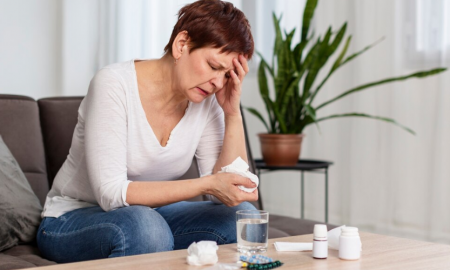
How to Get Out of a Depressive Slump With These Simple Tips

When feeling stuck in a depressive slump, it might seem like there’s no way out. However, understanding how to get out of a depressive slump can make a significant difference. Tackling depression as soon as symptoms develop can help people recover more quickly. Here are the tips that can help lift the fog of depression and improve your mood.
What Is a Depressive Slump?
A depression slump is a phase where an individual experiences a noticeable decline in mood and motivation. This period is marked by an overwhelming sense of lethargy, a lack of interest in activities that once brought joy, and feelings of disconnection from loved ones.

Freepik | A depression slump is a phase where an individual experiences a noticeable decline in mood and motivation.
How to Get Out of a Depressive Slump: 10 Effective Tips
1. Track Triggers and Symptoms
One effective method to combat depression is by tracking triggers and symptoms. Keeping a diary to log important events, changes to daily routines, and moods can be beneficial. This practice helps in understanding what might be triggering a depressive episode. By rating moods on a scale of 1-10, individuals can pinpoint specific events or activities that cause certain responses. Consulting a doctor is crucial if symptoms persist for more than 14 days.
2. Stay Calm
Recognizing the onset of a depressive episode can be unnerving, but staying calm is essential. Panicking or feeling anxious can worsen symptoms like loss of appetite and disrupted sleep. It’s important to remember that depression is treatable, and these feelings are temporary. Self-help techniques such as meditation, mindfulness, and breathing exercises can promote a sense of calmness. There are also self-help books and online counseling courses that provide valuable support.
3. Understand and Accept Depression
Learning more about depression can demystify the condition. Depression is a widespread mental health disorder and not a sign of weakness. Accepting that a depressive episode might occur from time to time can help in managing it when it does. Managing symptoms with lifestyle changes, medication, and therapy is possible. Understanding that this condition is part of a broader experience can help in dealing with it more effectively.
4. Separate Yourself from the Depression
It’s crucial to remember that you are not your depression. Some people find it helpful to repeat affirmations like, “I am not depression, I just have depression.” Reminding oneself of other roles and qualities can also be beneficial. Whether you are a parent, sibling, friend, or colleague, each person has strengths and positive attributes that define who they are beyond their mental health condition.
5. Recognize the Importance of Self-Care
Self-care is vital for maintaining both physical and mental health. This includes activities that help individuals look after their well-being. Self-care means taking time to relax, recharge, and connect with oneself and others. This might involve saying no when feeling overwhelmed and taking time to calm and soothe oneself. Basic self-care activities can include eating a balanced diet, engaging in creative activities, or taking a soothing bath.
6. Breathe Deeply and Relax the Muscles
Deep breathing techniques are a simple yet effective way to manage anxiety and reduce stress. Slowly inhaling and exhaling can provide physical and psychological benefits. Progressive muscle relaxation, which involves tensing and relaxing muscles throughout the body, can also help. Many smartphone apps offer guided exercises for both deep breathing and muscle relaxation.
7. Challenge Negative Thoughts
Cognitive Behavioral Therapy (CBT) is a proven method for treating depression. It involves changing negative thought patterns into more balanced ones to alter feelings and behaviors. While a therapist can offer CBT sessions, individuals can also practice challenging negative thoughts on their own. Noticing and challenging negative thoughts, like “I am not good enough,” and replacing them with positive statements, such as “I did my best,” can significantly alter one’s mood.
8. Practice Mindfulness
Mindfulness involves appreciating the present moment without worrying about the future or dwelling on the past. Simple practices like noticing the warmth of the sun or the taste of food can ground individuals in the present. Studies suggest that regular mindfulness can reduce symptoms of depression and improve responses to low mood.

Freepik | Mindfulness involves appreciating the present moment without worrying about the future or dwelling on the past.
9. Make a Bedtime Routine
Sleep has a profound impact on mood and mental health. Establishing a consistent sleep schedule, even on weekends, can help. Creating a nightly routine, such as winding down with chamomile tea, reading a book, or taking a warm bath, can also promote better sleep. Avoiding screens and caffeine before bed and writing in a journal can further enhance sleep quality.
10. Exercise
Exercise releases endorphins, which help improve mood. Regular physical activity has been shown to have a significant positive effect on symptoms of depression. Incorporating exercise into daily routines can be highly beneficial whether it’s a brisk walk, a run, or a yoga session.
Ask for Help When Depressive Slump Persists
Dealing with depression can feel overwhelming, but it’s important to remember that you don’t have to do it alone. Seeking support from family and friends can provide a much-needed emotional boost. They can offer encouragement, a listening ear, and practical help when needed.
Consulting a doctor is crucial for a proper diagnosis and tailored treatment plan. Medications, therapy, or a combination of both can be effective treatments for depression. Therapists can provide valuable support through talk therapy, helping you develop coping skills and strategies to manage depressive episodes.
More in Mental Health
-
Hematoma vs Bruise: What Is the Difference?
When it comes to injuries, hematoma vs bruise are often used interchangeably, but they refer to different medical conditions. Understanding the...
June 12, 2024 -
What Is Unipolar Depression? Here’s What You Need to Know Right Now
Depression casts a long shadow over many lives, with symptoms that affect everything from our energy levels to our ability to...
June 7, 2024 -
A Comprehensive Guide on How to Heal Anxious Attachment Style
If you often find yourself seeking constant reassurance from your partner or requiring endless validation to feel secure, you may be...
June 1, 2024 -
Why Is My Skin Peeling on My Face After Skincare? Here’s What You Need to Know
Experiencing skin peeling on your face after implementing a skincare routine can be perplexing and frustrating. This phenomenon, where the skin...
May 23, 2024 -
What Is a Mental Edge, and How Do You Get It?
Have you ever wondered why some individuals seem unshakably confident under intense pressure, finding a way to excel when it matters...
May 15, 2024 -
When to Worry About Varicose Veins? Here’s What You Need to Know
Varicose veins are a common issue, affecting about 20% of adults. They’re usually seen as unsightly blemishes on the legs but...
May 12, 2024 -
Why Is Discipline Important: The Ultimate Guide to the Importance of Discipline
Discipline is undoubtedly one of life’s most crucial character traits. It shapes how we approach tasks, manage our time, and...
May 3, 2024 -
Have I Fallen Out of Love or Am I Depressed? Everything You Need to Know
Have I fallen out of love or am I depressed? You’re not alone in this query. In the diversity of human...
April 26, 2024 -
What Does Lung Cancer Breath Smell Like?
Cancer is one of the most formidable diseases of our time, characterized by the uncontrolled growth of cells that invade and...
April 20, 2024















You must be logged in to post a comment Login